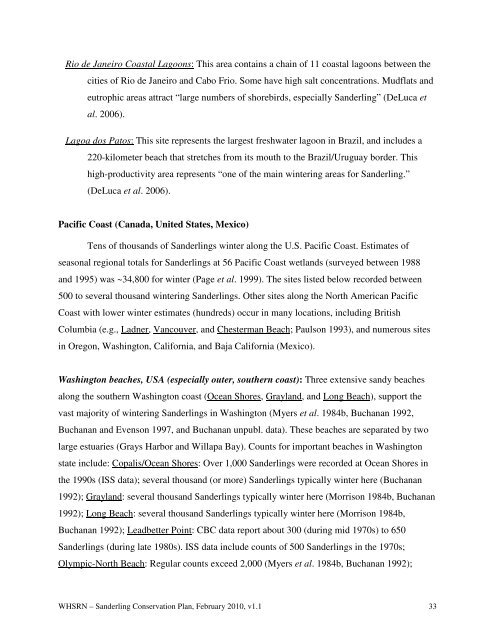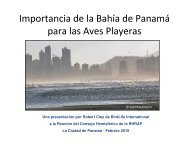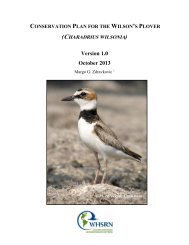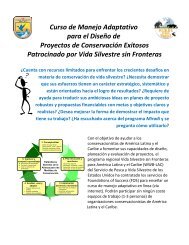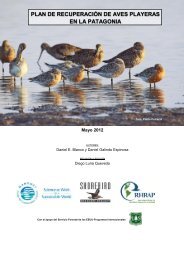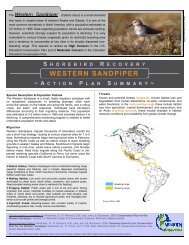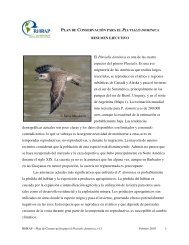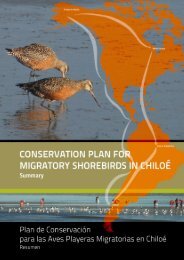Sanderling Plan - Western Hemisphere Shorebird Reserve Network
Sanderling Plan - Western Hemisphere Shorebird Reserve Network
Sanderling Plan - Western Hemisphere Shorebird Reserve Network
Create successful ePaper yourself
Turn your PDF publications into a flip-book with our unique Google optimized e-Paper software.
Rio de Janeiro Coastal Lagoons: This area contains a chain of 11 coastal lagoons between the<br />
cities of Rio de Janeiro and Cabo Frio. Some have high salt concentrations. Mudflats and<br />
eutrophic areas attract “large numbers of shorebirds, especially <strong>Sanderling</strong>” (DeLuca et<br />
al. 2006).<br />
Lagoa dos Patos: This site represents the largest freshwater lagoon in Brazil, and includes a<br />
220-kilometer beach that stretches from its mouth to the Brazil/Uruguay border. This<br />
high-productivity area represents “one of the main wintering areas for <strong>Sanderling</strong>.”<br />
(DeLuca et al. 2006).<br />
Pacific Coast (Canada, United States, Mexico)<br />
Tens of thousands of <strong>Sanderling</strong>s winter along the U.S. Pacific Coast. Estimates of<br />
seasonal regional totals for <strong>Sanderling</strong>s at 56 Pacific Coast wetlands (surveyed between 1988<br />
and 1995) was ~34,800 for winter (Page et al. 1999). The sites listed below recorded between<br />
500 to several thousand wintering <strong>Sanderling</strong>s. Other sites along the North American Pacific<br />
Coast with lower winter estimates (hundreds) occur in many locations, including British<br />
Columbia (e.g., Ladner, Vancouver, and Chesterman Beach; Paulson 1993), and numerous sites<br />
in Oregon, Washington, California, and Baja California (Mexico).<br />
Washington beaches, USA (especially outer, southern coast): Three extensive sandy beaches<br />
along the southern Washington coast (Ocean Shores, Grayland, and Long Beach), support the<br />
vast majority of wintering <strong>Sanderling</strong>s in Washington (Myers et al. 1984b, Buchanan 1992,<br />
Buchanan and Evenson 1997, and Buchanan unpubl. data). These beaches are separated by two<br />
large estuaries (Grays Harbor and Willapa Bay). Counts for important beaches in Washington<br />
state include: Copalis/Ocean Shores: Over 1,000 <strong>Sanderling</strong>s were recorded at Ocean Shores in<br />
the 1990s (ISS data); several thousand (or more) <strong>Sanderling</strong>s typically winter here (Buchanan<br />
1992); Grayland: several thousand <strong>Sanderling</strong>s typically winter here (Morrison 1984b, Buchanan<br />
1992); Long Beach: several thousand <strong>Sanderling</strong>s typically winter here (Morrison 1984b,<br />
Buchanan 1992); Leadbetter Point: CBC data report about 300 (during mid 1970s) to 650<br />
<strong>Sanderling</strong>s (during late 1980s). ISS data include counts of 500 <strong>Sanderling</strong>s in the 1970s;<br />
Olympic-North Beach: Regular counts exceed 2,000 (Myers et al. 1984b, Buchanan 1992);<br />
WHSRN – <strong>Sanderling</strong> Conservation <strong>Plan</strong>, February 2010, v1.1 33


